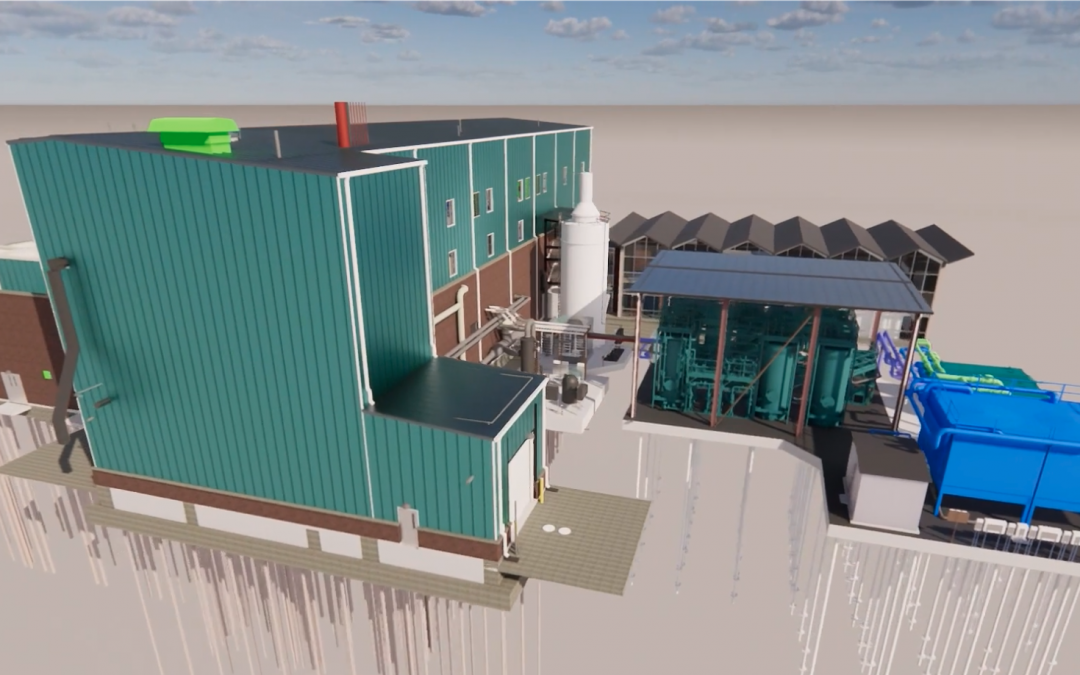Watch a Building Information Modeling (BIM) video tour.
Not only will the Blue River Biosolids Facility have the latest technology to process human waste into a useful agricultural product, the facility is also being designed using the latest architectural technology. Building Information Modeling (BIM) technology takes the place of traditionally-drawn 2D plans and physical 3D building prototype models. Instead, it allows designers to create a digital, visual representation of a future construction project that includes multiple disciplines (e.g. structural, mechanical, electrical, plumbing, and cost estimating).
A BIM model allows people to virtually “walk through” a facility model to experience a first-person view of how each aspect of construction is incorporated efficiently and effectively. BIM technology is approximately 10-years old and is similar to a virtual reality game for architects, engineers, constructors and operators. Those exploring with BIM can experience a model with virtual reality goggles, as well as on a computer screen using a web browser.
Here’s how the process used to be done:
- An architect created a 2D drawing of a structure, and maybe a physical, table-top 3D model for visual representation.
- The design was sent to a structural engineer to come up with a hand-drawn plan to ensure the structure could stand.
- Mechanical, electrical and plumbing engineers each sent their drawings to be incorporated.
- The final designs were sent to a construction crew, who were required to fix any conflicts in design that were found as the structure was being built.
With BIM, all disciplines, including the architect and structural, mechanical, electrical, and plumbing engineers incorporate their disciplines in a digital program at the same time. This allows for potential conflicts and clashes to be identified and remedied ahead of time, rather than in the midst of construction, saving money and time.
In fact, through “clash detection”, designers are warned by the BIM model when something they have added will not work with the rest of the design. Concepts like time, financing, light and air flow can also be incorporated into a BIM model.
The many uses of BIM – present and future
- BIM is not a software, but rather a product made by software platforms. Just as software like Microsoft Excel and Google Sheets are used to produce spreadsheets, software like Revit is used to produce a BIM model.
- Changes to the design can be made in either 2D mode or 3D mode, and the changes will reflect in the other mode. Spreadsheets of dimensions, equipment, and other elements can be downloaded from the BIM model for convenience.
- The BIM model will be used by KC Water long after design and construction of the Blue River Biosolids Facility is finished. Upon completion of construction, editing privileges will be transferred from Goodwin Brothers to KC Water so the BIM model can be altered for training purposes. Additionally, if KC Water adds equipment to the facility in the future, it can be easily incorporated into the BIM model to test for compatibility before it is purchased and installed.
- BIM specialists simply learn to use the software to create BIM models. Currently, there are 10 BIM modelers working on the Blue River Biosolids Facility design representing the various design and construction disciplines.
- The Blue River Biosolids Facility BIM model uses a 5’10” tall avatar referred to as Flat Stanley, to represent a person within the BIM Model. Users can also “drive” a truck on plant roads and through the truck bay for an accurate driving experience.
- One simple change that was made as a result of BIM modeling was the relocation of some light fixtures in the Biosolids building. While Blue River plant operators were taking a virtual tour through the building with a first-person view of the equipment, they noticed that the design included light fixtures that were located above a prominent piece of equipment. While the position of the fixtures provided adequate lighting for work purposes, the operators pointed out that they would not have access to the fixture to change the light bulbs due to the large equipment underneath. They were able to identify the problem before construction, and electrical engineers were able to move light fixtures to an equally useful, easily accessed position.

